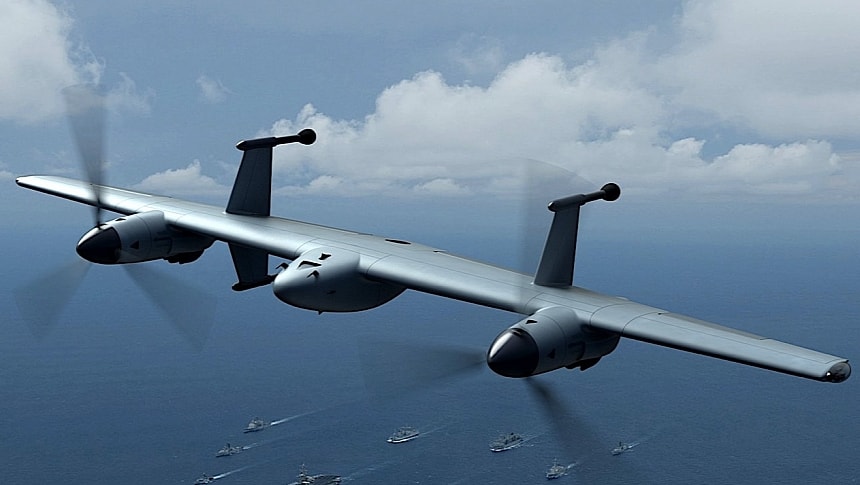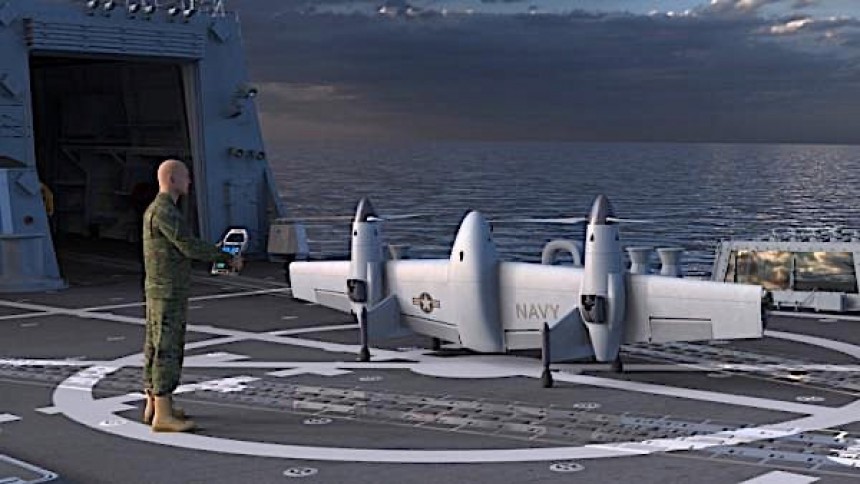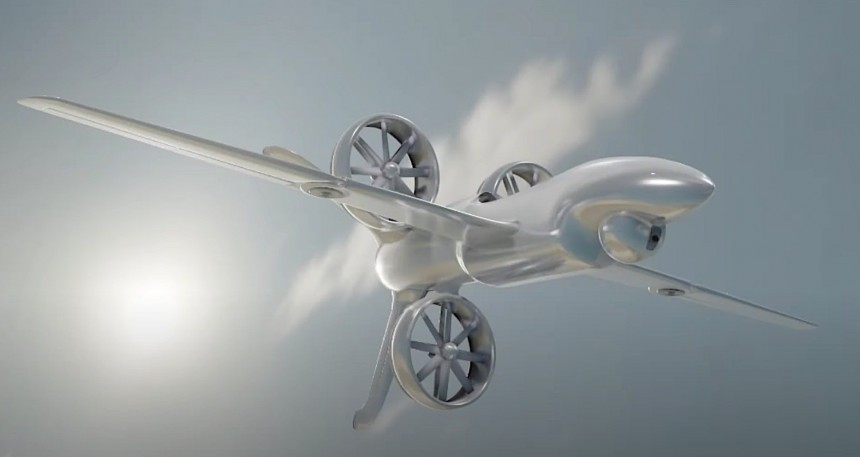About a year ago the Defense Advanced Research Projects Agency (DARPA) introduced to the world the companies that were tasked with working on something called the AdvaNced airCraft Infrastructure-Less Launch And RecoverY (ANCILLARY) program. Nothing notable happened on that front since then, until this week one of the participants, Sikorsky, gave us a first look at the insane aircraft it is working on.
The goal of the ANCILLARY effort is to come up with a vertical take-off and landing (VTOL) drone that can be launched and retrieved without the specialized tools used to operate some of the drones with such capabilities today.
In design terms that means we're going to have on our hands a type of uncrewed aircraft that takes off and lands just like a helicopter, but when in flight it transitions to an airplane-style means of travel. This should make it ideal for use from the deck of small ships and remote locations., but capable enough to carry "a significant amount of payload for a variety of missions" over large distances.
DARPA did not explicitly tell the nine companies it selected for the project how to go about this. What that means is that the nine (AeroVironment, AVX Aircraft, Griffon Aerospace, Karem Aircraft, Leidos, Method Aeronautics, Northrop Grumman, Piasecki Aircraft, and Sikorsky) will probably come with some truly wacky designs for the project.
You only have to look at what Sikorsky is doing to know that is so. The American helicopter maker stepped into the spotlight this week with something it calls a tail-sitting rotor blown wing VTOL unmanned aircraft system (UAS).
Now, aircraft that lift and land like a helo but fly like an airplane we've seen before, and we generally call them tilt rotors. This thing, however, is something else altogether.
First let's get a sense of what a rotor blown wing is supposed to mean. As seen in the photos of the drone released by Sikorski, its shape is that of a flying wing, with a center body and two engines with the corresponding propellers placed on either side of that. The strange vertical structures you see left and right of what's supposed to be the cockpit are the drone's landing legs.
The thing uses these legs to stay upright on the launch pad, with its rotors placed in a position that mimics that of a helicopter. After it gets airborne, the drone tips over completely, turning itself into a sort of fixed-wing aircraft. The rotors used for such a design, which can act both as a helicopter rotor and an airplane propeller, are called proprotors.
What rotor blown wing is supposed to mean has to do with how the thing flies. The term refers to the constant flow of air that goes over the proprotor wash across the wing. It's an approach that should give the drone's wing a shot at experiencing less drag when hovering and transitioning to horizontal flight.
The aircraft would use the company's Matrix autonomous system, the same one that was put in full control of an uncrewed military Black Hawk not long ago, but also flown on a S-76B medium-size rotorcraft. The system is so capable that it managed to help the two helicopters, during the same flight, avoid one another by usint a collision avoidance software developed by NASA.
The helicopter maker is already at work test flying a proof-of-concept version of the drone trying to see how the concept performs when in actual use. The prototype used for this is powered by a battery, but other than that we don't know much about it.
If DARPA is satisfied that this design is what it is looking for ANCILLARY, Sikorsky says, it will assemble another, larger prototype for further testing. That one will weigh 300 pounds (136 kg), and will be capable of carrying a 60-pound (27 kg) payload. Its powertrain will comprise a yet undisclosed hybrid-electric setup.
The idea behind this entire exercise in design from the helicopter maker is to make the tail-sitting rotor blown wing VTOL scalable, meaning the thing could come in different sizes in the near future, and the technologies made for it could be implemented in other types of aircraft.
As it stands, however, DARPA plans to use whatever hardware results from the ANCILLARY to come up with new drones that can be used for long-endurance intelligence, surveillance, and reconnaissance (ISR) missions.
Targetting and possibly even search and rescue could also be performed by these drones, but most importantly the idea is to create swarms of these things to assemble "a tactical beyond-line-of-site (BLOS) multi-intelligence sensor network."
DARPA did not mention when it expects some tangible results from the ANCILLARY program, so chances are we're still a long time away from the moment these new drones will actually get to fly.
In the meantime, we'll keep an eye out for what the other companies involved have planned, and report back when we learn something of interest.
In design terms that means we're going to have on our hands a type of uncrewed aircraft that takes off and lands just like a helicopter, but when in flight it transitions to an airplane-style means of travel. This should make it ideal for use from the deck of small ships and remote locations., but capable enough to carry "a significant amount of payload for a variety of missions" over large distances.
DARPA did not explicitly tell the nine companies it selected for the project how to go about this. What that means is that the nine (AeroVironment, AVX Aircraft, Griffon Aerospace, Karem Aircraft, Leidos, Method Aeronautics, Northrop Grumman, Piasecki Aircraft, and Sikorsky) will probably come with some truly wacky designs for the project.
You only have to look at what Sikorsky is doing to know that is so. The American helicopter maker stepped into the spotlight this week with something it calls a tail-sitting rotor blown wing VTOL unmanned aircraft system (UAS).
Now, aircraft that lift and land like a helo but fly like an airplane we've seen before, and we generally call them tilt rotors. This thing, however, is something else altogether.
The thing uses these legs to stay upright on the launch pad, with its rotors placed in a position that mimics that of a helicopter. After it gets airborne, the drone tips over completely, turning itself into a sort of fixed-wing aircraft. The rotors used for such a design, which can act both as a helicopter rotor and an airplane propeller, are called proprotors.
What rotor blown wing is supposed to mean has to do with how the thing flies. The term refers to the constant flow of air that goes over the proprotor wash across the wing. It's an approach that should give the drone's wing a shot at experiencing less drag when hovering and transitioning to horizontal flight.
The aircraft would use the company's Matrix autonomous system, the same one that was put in full control of an uncrewed military Black Hawk not long ago, but also flown on a S-76B medium-size rotorcraft. The system is so capable that it managed to help the two helicopters, during the same flight, avoid one another by usint a collision avoidance software developed by NASA.
The helicopter maker is already at work test flying a proof-of-concept version of the drone trying to see how the concept performs when in actual use. The prototype used for this is powered by a battery, but other than that we don't know much about it.
The idea behind this entire exercise in design from the helicopter maker is to make the tail-sitting rotor blown wing VTOL scalable, meaning the thing could come in different sizes in the near future, and the technologies made for it could be implemented in other types of aircraft.
As it stands, however, DARPA plans to use whatever hardware results from the ANCILLARY to come up with new drones that can be used for long-endurance intelligence, surveillance, and reconnaissance (ISR) missions.
Targetting and possibly even search and rescue could also be performed by these drones, but most importantly the idea is to create swarms of these things to assemble "a tactical beyond-line-of-site (BLOS) multi-intelligence sensor network."
DARPA did not mention when it expects some tangible results from the ANCILLARY program, so chances are we're still a long time away from the moment these new drones will actually get to fly.
In the meantime, we'll keep an eye out for what the other companies involved have planned, and report back when we learn something of interest.















